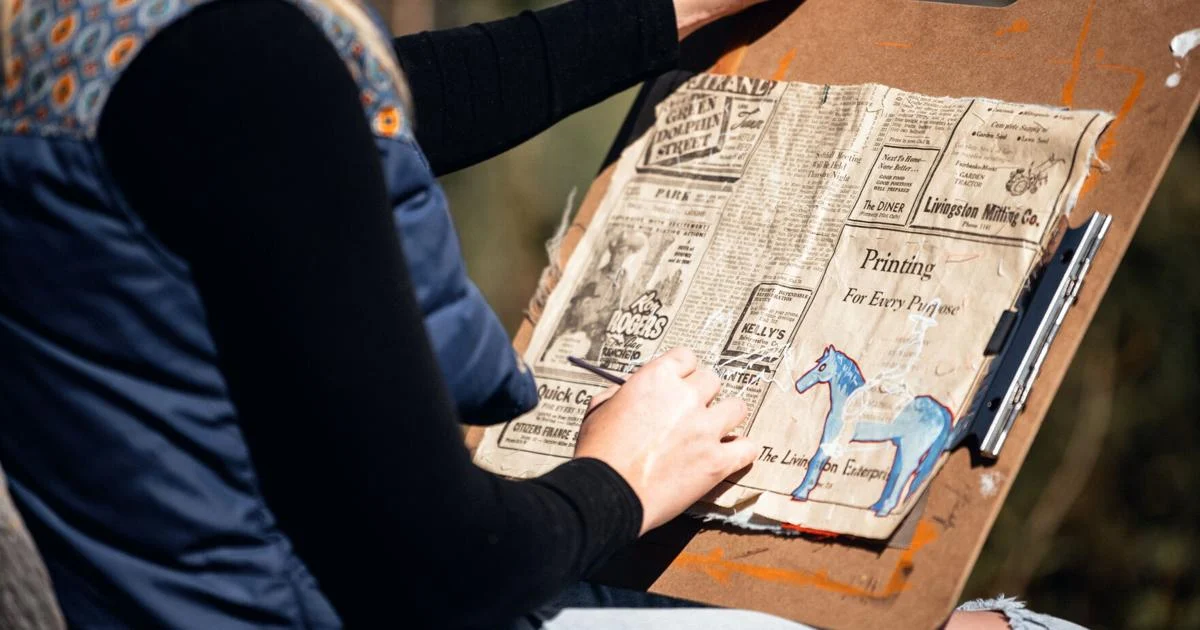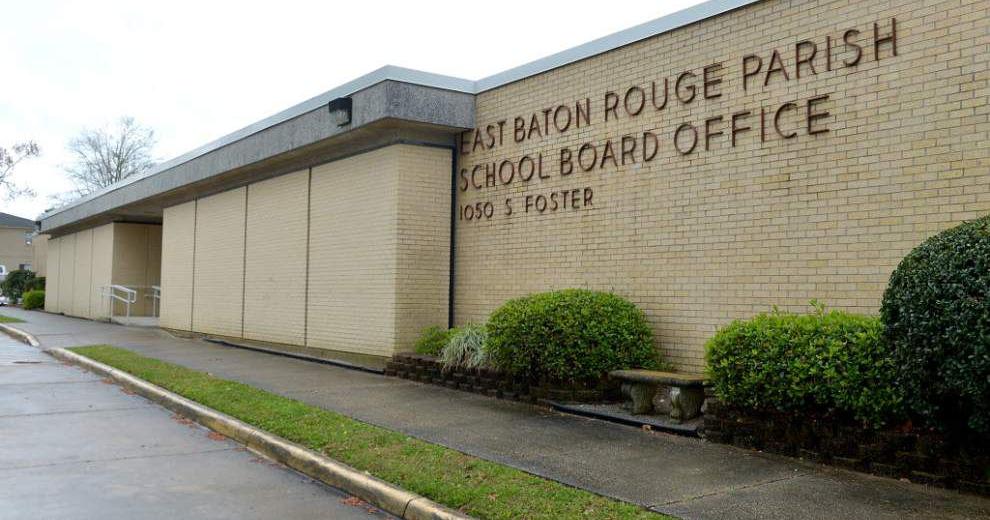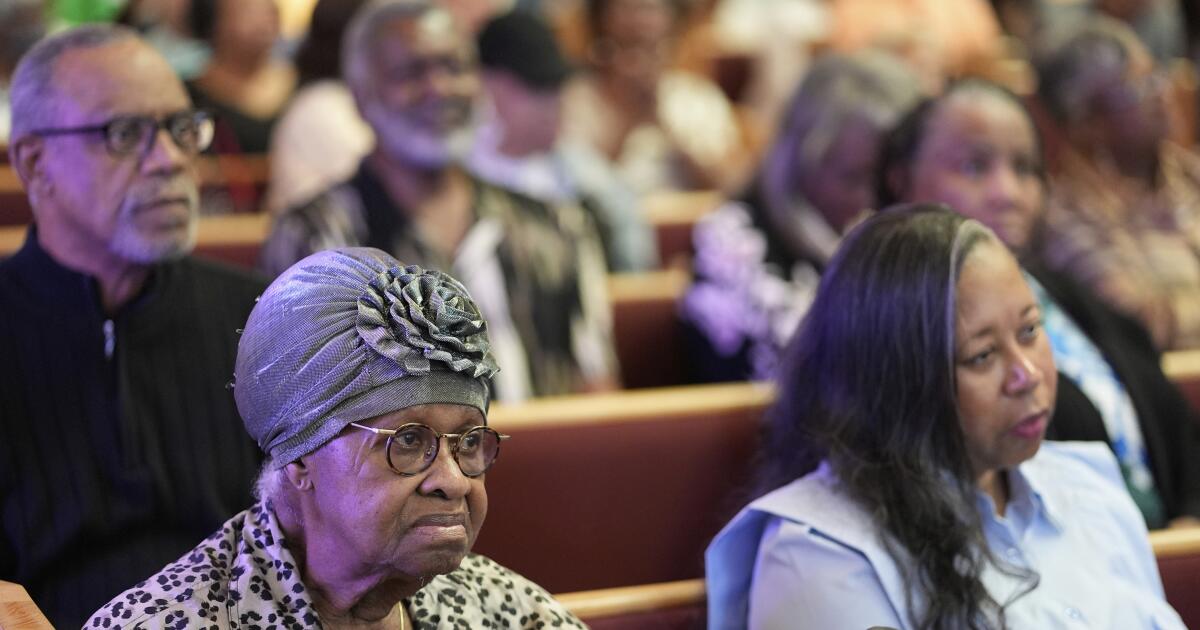
SEELEY LAKE — At the edge of the water with the Swan Range sprawling across the skyline, Miah Real Bird was painting a figure on horseback on a square of newspaper from the Livingston area that was around a hundred years old.
Ledger art, a Plains Indian tradition, that can be painstaking, she said. The antique paper, which her ancestors began to use in place of buffalo hide to record stories, is fragile. Each sheet responds differently to pens and brushes. It requires intention when you begin to make a mark.
“There’s no going back. There’s not really any erasing, or any mistakes, it’s letting that energy flow through you,” Real Bird said.
The stillness on the water seemed ideal for concentration. She was here at Camp Paxson for four days as part of Ways of Water, a new annual retreat for Indigenous artists that featured presentations on marketing and building a business as well as ample time to work away from the demands of daily life.
“For me personally, I just really wanted to have a space to create. I have a really busy life outside of a retreat like this,” she said.
An enrolled member of the Northern Cheyenne Tribe, she drove over from Kirby, tucked in the area southwest of Lame Deer. She and her partner live on a ranch, their families raise bucking horses, so this new retreat was a welcome opportunity “to come to a space where you can just dedicate yourself to your work, and get to be surrounded by beautiful trees and mountains,” she said.
A new program
“Ways of Water” is a new effort from the Larch Outdoor Education Program based at Paxson. The artists get rooms in the cabins and catered meals, time to work on projects, as well as presentations from an intellectual property lawyer, a museum curator, an accountant and a photographer.
Libby Schneider, the executive director of the Camp Paxson Preservation Project, said it’s all designed to support Indigenous art.
“It’s such a cultural treasure that we have in Montana that’s not recognized like it should be. It’s not valued like it should be, and it’s not promoted like it should be, and we don’t provide enough education for Native artists to be able to market themselves and make a living and have space to create and space to bring their art into Montana,” Schneider said.
Camp Paxson, a property on the west edge of Seeley Lake on National Forest land, comprises a lodge with an array of cabins. Missoula Children’s Theatre held the lease for years and was managed by Schneider’s father, John Torma. Eventually, MCT transferred the lease to Torma, who continued to manage it for various uses, from summer camps to weddings, family reunions and more.
The camp now operates under the Camp Paxson Preservation Project and the Larch Outdoor Education Program. Schneider said they wanted to expand their offerings in the shoulder seasons and someone suggested an artist retreat. They’d also hoped to do more outreach to Native schools, so the idea evolved into a retreat for Indigenous artists.
To develop the applications and programs, Schneider consulted with Tailyr Irvine, a Salish and Kootenai freelance photographer who works with national publications like the New York Times and Washington Post.
“The idea is to help these artists at the front of their careers before they start going into the business side,” said Irvine, who grew up on the Flathead Reservation and is based in Missoula.
Irvine said she passed along ideas, such as advice artists and photographers like herself would benefit from early in their careers: marketing, pricing, taxes, copyrights and contracts. They might be the first artist or businessperson in their family and won’t have anyone to turn to for advice, she said.
John Calsbeek, the senior curator from the Missoula Art Museum, gave a presentation on working with galleries and museums — how to do outreach on proposals and red flags to watch out for in contracts. Irvine said that’s a good introduction to the art world, which can be intimidating, but in Montana is more accessible than it might seem at first.
Chris Autio, an art photographer who has a professional business shooting pictures of other artists’ work, talked about how to document your work and did one-on-one consultations. Doug MacDonald, an accountant, also spoke and did individual sessions on business practices.
Listen now and subscribe: Apple Podcasts | Google Podcasts | Spotify | YouTube | RSS Feed | Omny Studio
Jennifer Webber, a trained Billings lawyer who started a new consulting outfit, Entrepreneurship Collective, talked about topics like intellectual property.
The 10 artists were selected from an open application process that drew 16 total. Schneider hopes they get more in the future, with numbers kept small for the first year. She said she’s open to ideas from the artists. Even in the application process, they asked what people wanted from the program regarding offerings and presentations.
Schneider and the nonprofit privately fundraised for the project and hope to land a large grant for work with Native schools. To make it accessible, they also included a stipend so applicants could afford to travel and take time off from other jobs or obligations.
“That’s something that our collective Western culture has done very poorly, is taking subjective work and not allowing a monetary value to be placed on it … if I can help that from the consumer side, build the confidence in artists to be able to value their work and also be okay with walking away from something that doesn’t feel valued, then at least we can change our little corner over here,” she said.
The concept extended to food as well: meals were catered by Qene’s Catering, run by Trina Fyant (Bitterroot Salish/Blackfeet) based out of Arlee. The atmosphere was laid back and informal. A few artists brought their families or partners, there were dogs playing outside.
Eight artists were here for the first installment (two had to withdraw due to family or school reasons). They’re all from Montana, except one artist from Portland, Oregon, who has Montana ties.
For the spring, they’re aiming to have an exhibition at the MAM that artists can apply for, with a stipend if their work is selected.
All styles welcome
The retreat was open to artists of any medium. There were a number of beaders, including Desiree Rowland, who grew up in Lame Deer on the Northern Cheyenne Reservation and now lives in Missoula, often traveling home to help care for her father.
She makes large earrings from long narrow dentalium shells, as well as Cheyenne orchids and tries her hand at many other projects, such as a flashy white-brimmed hat with decorative flourishes. Thanks to Instagram, she’s had orders from New York, Florida and Virginia. She also paints in a figurative style, arranged so that the people on the canvas can “wear” her jewelry.
Besides the presentations, she thought the retreat has been good for networking. She met other artists from the Cheyenne Reservation, as well as the MAM curator and more.
It’s been relaxing, she said, with no pressure to work at any sort of schedule. She was excited to try out canoeing.
In the lodge, the beaders had room to spread out and work. They’d all talked about how beading is usually pushed to the start of the day or the very end.
“You do everything you’re supposed to do during the day. You take care of your family. Everyone’s in bed, and then there’s time for you to get that stuff done,” she said.
Real Bird focuses on ledger art, the subject of growing popularity in western Montana among artists as well as galleries and museums.
An enrolled member of the Northern Cheyenne tribe, Real Bird (whose work hangs under her maiden name, Chalfant) entered and was selected for a statewide juried exhibition, “19 Under 39: Montana’s Emerging Artists,” at the Montana Museum of Art and Culture. Her works in the exhibition, which closes Sept. 23, included a portrait painted on a bison hide titled “Grandmother’s Wisdom.”
After the U.S. government removed tribes from their homelands, “we had to find another means of telling our stories,” she said. Ledger paper, often with writing on it, became the canvas.
“It still conveys the stories that we were telling at the fire at night, the things that we were giving to each other through oral histories and passing down,” she said.
She sources imagery from historical photographs from her tribe and looks at ways to tie traditional ways of life to contemporary ones, she said. After all, it’s ancient paper that you can draw on with modern colors and subject matter.
“We’re still here. We’re still doing all of the things that we’ve done before — it’s just in a different way now, and we’re still participating in our spirituality, we’re still participating in our culture and our identities, but we’re doing it through a modern lens,” she said.
Cory Walsh is the arts and entertainment reporter for the Missoulian.
You must be logged in to react.
Click any reaction to login.
Love
0
Funny
0
Wow
0
Sad
0
Angry
0
Be the first to know
Get local news delivered to your inbox!
* I understand and agree that registration on or use of this site constitutes agreement to its user agreement and privacy policy.
Cory Walsh
Arts and Entertainment Reporter
Get email notifications on {{subject}} daily!
Your notification has been saved.
There was a problem saving your notification.
{{description}}
Email notifications are only sent once a day, and only if there are new matching items.
Followed notifications
Please log in to use this feature
Log In
Don’t have an account? Sign Up Today



